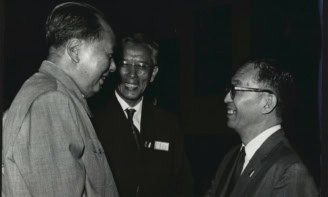
A nearly 400 year-old formula for pi has been spotted in a quantum-mechanics formula for the energy states of the hydrogen atom, according to researchers in the US. Derived by English mathematician John Wallis in 1655, the original formula calculates pi as the product of an infinite series of ratios – it has now emerged from a solution of physicist Niels Bohr’s early 20th-century hydrogen-atom model, which most budding physicists learn.
University of Rochester physicist Carl Hagen was designing homework problems for his graduate quantum-mechanics class when a particular exercise for the hydrogen atom intrigued him. It posed a twist on the Bohr model of hydrogen, which approximates the atom as an electron orbiting a point-like positive nucleus in circles. The Bohr model, while not an accurate description of an atom, is often close enough to the real thing in many situations. It is especially so when teaching physics, because it is one of the few systems that can be solved analytically by Schrödinger’s equation – that is, it can be solved exactly, rather than making approximations or using a computer program.
Varying homework
But instead of solving the Bohr-model problem, Hagen applied the “variational principle” – a technique usually reserved for approximating quantum-mechanical systems that cannot be solved analytically with the Schrödinger equation. The technique involves making an educated guess of the hydrogen’s wavefunction and then optimizing that guess. Hagen found that as the atom’s orbital angular momentum increased, the allowed energies of the predicted atom approached and gradually equalled the analytically found hydrogen energies. Indeed, Hagen noticed that the error of the variational approach was about 15% for the ground state of hydrogen, 10% for the first excited state, and kept decreasing as the excited states grew larger. This was unusual, because the variational approach normally works best for approximations of the lowest energy levels.
Hidden formula
Hagen turned to his colleague, mathematics professor Tamar Friedmann, who found that they could derive Wallis’s infinite product from the ratio of the approximate energies to the exact energies. Friedmann points out how unexpected it is that a centuries-old math formula, derived under completely different motivations, has been lurking in a basic quantum-mechanics problem. Wallis’s original 1655 infinite-series formula, published in his book Arithmetica infinitorum, predates Newton’s invention of calculus, and arose when he was trying to relate the area of a square to the circle inscribed within it.
“Wallis couldn’t have possibly known [the trend] would show up in the hydrogen atom because no-one knew about the hydrogen atom then,” Friedmann says. She adds that, while the formula could have been found ever since Bohr developed his model in 1913, the pair were the first to spot it, probably thanks to their interdisciplinary experience. Their findings suggest that more mathematical formulae could lie in wait in other seemingly well-studied systems.
Universal pi?
“I’m not surprised that pi is in there. Pi is everywhere,” says Drew Milsom, a physicist at the University of Arizona. While the most obvious appearance of pi is the ratio of a circle’s circumference to its diameter, Milsom cites another example in probability studies – known as “Buffon’s needle problem” – that finds that the probability of a falling matchstick landing between two lines is related to pi. What is more surprising, Milsom says, is that Hagen and Friedmann decided to use the variational principle and actually recognized the Wallis formula, which is obscure to most physicists.
It is ultimately unsurprising that the pi formula emerged from the quantum solution because, as Friedmann herself points out, “mathematical formulae come up in physics all the time”. She adds that finding the link “is a manifestation of the ultimate connection between math and physics”, but whether there exists some deeper, fundamental correlation between the two remains unknown.
“Once you see it, it’s clear and beautiful and you can understand it, even if you weren’t able to derive it,” says Friedmann, adding that it could now even be taught to undergraduates. “Physical problems inspire questions in mathematics and vice versa,” Friedmann says. “Mathematics is the language that describes physics. Learning one helps enrich the other.”
The research is described in the Journal of Mathematical Physics.



